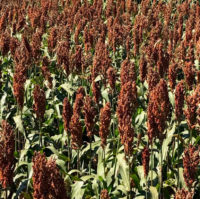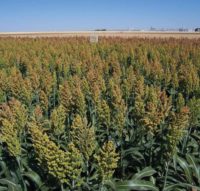GS-855
 – Resistant to Anthracnose, downy
– Resistant to Anthracnose, downy
– Great for late planting conditions
– Excellent standability
– Exceptional yield for maturity
This hybrid has a large, red grain head and high-test weight. A semi-open panicle and good head exsertion allow for great threshability, while late season standability is an improvement over other ultra-early hybrids. Tillers are approximately the same height of the main panicle and helps this hybrid maintain its uniformity in the field.
PLANT CHARACTERISTICS
- Grain Color – Red
- Plant Color – Purple
- Days to Midbloom – 52
- Standability – 8
- Plant Height – 42-48 in.
- Panicle Type – SO
GRAIN SORGHUM
GS-750

– Anthracnose tolerant
– Food grade
– Excellent yield potential
This is a medium-early maturity hybrid that produces high density, high test weight, white grain. It has high tolerance to drought and will produce outstanding yields. The semi-open panicle has good exertion and is easy threshing. Standability is very good because of a stiff stalk and strong, deep roots. Grain threshes well from the panicle during harvest.
PLANT CHARACTERISTICS
- Grain Color – White
- Plant Color – Tan
- Days to Midbloom – 58
- Standability – 8
- Plant Height – 40-45 in.
- Panicle Type – SO
GRAIN SORGHUM
GS-875DT
– Tolerates FirstAct herbicides
– Excellent emergence
– Great system for wildlife food plots
GS-875DT is a bronze grain hybrid with great yield potential that hs the Double Team trait. The Double Team trait gives you opportunities for superior over-the-top grass week control. If your wildlife food plots are becoming overtaken by foxtail or sandbar, this hybrid is the best option.
PLANT CHARACTERISTICS
- Grain Color – White
- Plant Color – Purple
- Days to Midbloom – 57
- Standability – 7
- Plant Height – 44-50 in.
- Panicle Type – SO
GRAIN SORGHUM
FS-275DT
– Tolerates FirstAct herbicide
– Over-the-top grass weed control
– High grain content for high quality silage
FS-275DT is a Double Team hybrid that produces quality silage because of its large grain head. It is also suitable for wildlife food plots because of its compact stature.
PLANT CHARACTERISTICS
- Days to Harvest – 105
- Plant Height – 6-7 ft.
FORAGE SORGHUM
FS-300 II
– Low lignin content for a conventional
– High grain-to-forage ratio
– Average stalk sweetness
FS-300 II is best adapted for high quality beef or dairy silage environments. It produces high quality silage because of its large grain head and low lignin content.
PLANT CHARACTERISTICS
- Days to Harvest – 100
- Plant Height – 6-7 ft.
FORAGE SORGHUM
FS-300BMR
– Very early maturity
– Best suited for double cropping
FS-300BMR is one of the earliest BMRs out there. The tillering capabilities of this hybrid are unsurpassed, allowing for increased yields and ground cover.
PLANT CHARACTERISTICS
- Days to Harvest – 88
- Plant Height – 7ft.
FORAGE SORGHUM
FS-3100 BMR
– Excellent yield
– Unmatched standability
– Producer and custom choppers dream hybrid
FS-3100BMR is an early maturing, very high yielding, BMR Brachytic Dwarf forage sorghum. This hybrid gets approximately 6 feet tall and has exceptional standability. The panicle produces large amounts of red grain that is high in starch, which makes for an excellent grain to stover ratio.
PLANT CHARACTERISTICS
Days to Harvest – 100
Plant Height – 6 ft.
FORAGE SORGHUM
FS-600MS
– Male sterile keeps nutrients in the stalk
– High levels of nutrients create a sweeter and highly palatable feed
– Produces premium hay
– Excellent digestibility
FS-600MS is a male sterile hybrid that is suitable for silage or to winter graze. It will not produce seed unless pollinated by another sorghum. This hybrid is high yielding and produces excellent quality hay, green chop, and silage.
PLANT CHARACTERISTICS
- Days to Harvest – 95
- Plant Height – 8-9 ft.
FORAGE SORGHUM
FS-500 BMR
– Great dual-purpose hybrid
– Economical
FS-500BMR is very versatile as it works for silage or can be put in a bale. It is extremely palatable and very economical.
PLANT CHARACTERISTICS
- Days to Harvest – 95
- Plant Height – 8-9 ft.
FORAGE SORGHUM
SS-605
– Late maturing
– Wide range of adaptability
– Proven
This sorghum-sudangrass produces thick, vigorous stands of fine-stemmed forage. It has excellent digestibility as compared to competing sorghum-sudans. With its late maturing nature, producers value this hybrid when harvest is delayed due to weather or other factors.
PLANT CHARACTERISTICS
- Days to Maturity – 95
- Plant Height – 11-12 ft.
SORGHUM-SUDANGRASS
SS-605BMR
– Excellent tillering and regrowth
SS-605BMR is a brown midrib sorghum-sudangrass hybrid with excellent vigor and drought tolerance. Its exceptional palatability and digestibility makes this the variety of choice for many stockmen. This hybrid has excellent regrowth potential for both haying or grazing.
PLANT CHARACTERISTICS
- Days to Maturity – 68
- Plant Height – 9-10 ft.
SORGHUM-SUDANGRASS
Alfalfa SB-1942
PLANT CHARACTERISTICS (rating 1=Excellent 9=Poor)
- Winter Survival – 1.7
- Fall Dormancy – 3.7
- Recovery – Fast
- Wisc. Disease Rating – N/A
- Leaf to Stem Ratio – Very Good
- Forage Quality – High
- Bacterial Wilt – Resistant
- Verticillium Wilt – Resistant
- Fusarium Wilt – Resistant
- Anthracnose – Resistant
- Phytophthora – Highly Resistant
- Aphanomyces Race I & II – Resistant
ALFALFA
Alfalfa SB-4118
SA-4118 is an ideal choice for the producer looking for that deep rich green foliage plus high yield with quality. SA-4118 was selected to handle the heavy wheel traffic at harvest. This is a long rotation alfalfa with outstanding persistence. SA-4118 is your ultimate choice where Aphanomyces is a problem. This variety will handle all soil types and gives you an outstanding ideas resistant package. This variety will branch foot when conditions are wet and works great in heavy ground. SA-4118 is an outstanding choice for the producer who demands the complete package with high yield plus quality.
PLANT CHARACTERISTICS (rating 1=Excellent 9=Poor)
- Winter Survival – 1.8
- Fall Dormancy – 4.1
- Recovery – Very Fast
- Wisc. Disease Rating – 35/35
- Leaf to Stem Ratio – Excellent
- Forage Quality – High
- Bacterial Wilt – Highly Resistant
- Verticillium Wilt – Highly Resistant
- Fusarium Wilt – Highly Resistant
- Anthracnose – Highly Resistant
- Phytophthora – Highly Resistant
- Aphanomyces Race I & II – Highly Resistant
ALFALFA
Hunt-N-Time
A consistent 5’ tall red headed cane that sets a very large grain head. This premium product provides excellent dense cover to hold the birds every time.
PLANT CHARACTERISTICS
- Grain Color – Red
- Plant Height – 60-66 in.
FOOD PLOTS
Buck-N-Cock
Buck-N-Cock is a white headed, 4 ft. tall forage sorghum. Pheasants and deer love the white grain because of its high palatability. Because of its extreme leafiness, this product works great planted or drilled. To achieve great standability, plant at 5lbs. per acre.
PLANT CHARACTERISTICS
- Grain Color – White
- Plant Height – 48-54 in.
FOOD PLOTS
Foxtail Hay Millet
GOLDEN GERMAN AND WHITE WONDER
Foxtail hay millets are Summer Annual Forages most often grown for hay production. They are fairly quick to maturity, which works well in a double crop situation. Both Golden German and White Wonder are excellent options. Golden German is a little finer stemmed than White Wonder, but White Wonder is slightly taller. Plan to cut roughly 45 days after emergence.
MILLET
Hybrid Pearl Millet
HYBRID PEARL MILLET & HYBRID PEARL MILLET BMR
Hybrid Pearl Millet is a warm-season annual grass commonly used for livestock forage. Having excellent seedling vigor, it is very quick to establish and can be ready for grazing or haying in as little as four weeks after emergence. Unlike sorghum-sundangrass, there is no risk of prussic acid poisoning with Hybrid Pearl Millet. It has a very fine stalk and has a high leaf to stem ratio.
MILLET
3 Way and Custom Blends
Radish 50%, Turnips 25%, Rape Seed 25%. This blend was developed to be seeded into harvested small grain acres where your volunteer crop will provide your grass component. The three-way blend is also very economical.
Sokoto Seeds is dedicated to the long term success of the producer. Soil health is a the forefront of all long term plans. We are proud to offer all seeds that are needed for your cover crops and soil health needs. We know that each farm and ranch has different needs and we accommodate that with offering custom blends. We do offer two stock blends that cover a large variety of needs.
COVER CROPS
Graze Rx
COVER CROPS
Forage Winter Wheat • Triticale • Rye • Barley • Oats • Oats with Peas
SMALL GRAINS
Premium All Around and More
Equal parts of Pubescent Wheatgrass, Slender Wheatgrass, Western Wheatgrass, Meadow Brome Crested Wheatgrass, and Orchardgrass. The Premium All Around will give you the option for great grazing or hay production.
Sokoto Seeds produces and processes a wide range of grass seeds. We offer all grasses individually and in blends. Whether it is a conservation project or reclaiming crop ground back into grazing lands, custom grass blends is our specialty. Our most popular blend is the Premium All Around.

